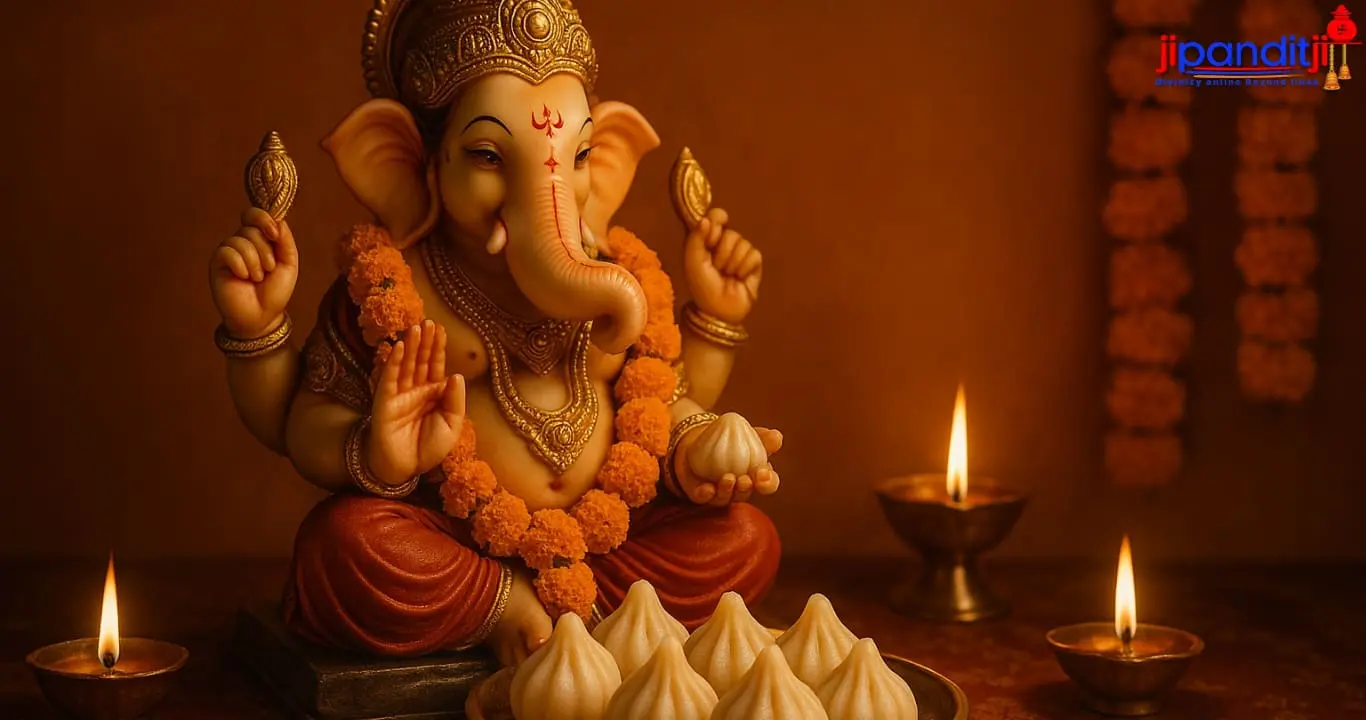Offer Modak to Lord Ganesha Today: The Secret Rituals to Please the Vighnaharta

In Hindu culture, Lord Ganesha holds a place of utmost reverence. Known as Vighnaharta (the remover of obstacles) and Siddhivinayak (the giver of success), he is the first deity invoked before starting any new work, ceremony, or puja. Devotees believe that worshipping Ganesha with sincerity and offering him his favorite items brings prosperity, success, and harmony in life.
Among all offerings, modak is considered the dearest to Lord Ganesha, which is why he is lovingly called Modakpriya. Alongside modaks, sacred items like durva grass, hibiscus flowers (gudhal), and coconut play a vital role in Ganesha worship. Each of these has deep symbolic meanings and spiritual power that helps devotees connect with the divine energy of Lord Ganesha.
Today is an especially auspicious day to make these offerings and seek his divine blessings. This article will guide you through the significance, rituals, and benefits of these offerings in detail, helping you understand how to please Lord Ganesha in the most effective way.
Why Modak is Lord Ganesha’s Favorite Offering
Modak is not just a sweet—it represents knowledge, fulfillment, and bliss. Scriptures and legends highlight why modak is closest to Ganesha’s heart.
- Symbol of Bliss: In Sanskrit, modaka means “that which gives joy.” Offering modaks is symbolic of wishing Lord Ganesha eternal bliss, and in return, devotees are blessed with inner joy.
- Nutritional & Energetic Value: Traditional modaks are made with jaggery, coconut, and rice flour—ingredients that are not only nutritious but also represent sweetness, strength, and purity.
- Mythological Connection: According to mythology, Ganesha once consumed an enormous number of modaks, which made him so full that he tied a snake around his belly. The moon laughed at him, leading to Ganesha’s curse on the moon. This story is a reminder of the deep bond between Ganesha and modaks.
Traditionally, devotees offer 21 modaks during Ganesh puja, symbolizing completeness and divine blessings.
Significance of Other Offerings
1. Durva Grass (Doob)
Durva grass is considered one of the most sacred offerings to Lord Ganesha.
- Cooling Energy: Ganesha represents fiery energy, and durva helps balance and calm it down.
- Symbolism: The three blades of durva represent purity in thought, word, and deed.
- Prosperity Magnet: Ancient texts mention that offering durva attracts financial stability and growth in business.
2. Hibiscus Flowers (Gudhal)
Flowers are essential in Hindu worship, and hibiscus holds a special place in Ganesha’s puja.
- Spiritual Strength: The red hibiscus represents power, courage, and devotion.
- Negativity Removal: It is believed that hibiscus offerings destroy negative energies and obstacles.
- Success in Endeavors: Devotees who offer hibiscus flowers often pray for success in education, career, and family life.
3. Coconut
The coconut is regarded as a complete and pure offering in Hindu rituals.
- Breaking Ego: When devotees break a coconut before Ganesha, it symbolizes breaking their ego and surrendering to divine will.
- Purity of Mind: Coconut water symbolizes clarity of thoughts, while the kernel represents nourishment and fulfillment.
- Family Harmony: Offering coconut is believed to bring unity, prosperity, and peace within the family.
Step-by-Step Ritual to Please Lord Ganesha
Performing a ritual with devotion and purity enhances the power of offerings. Here is a step-by-step guide:
- Purify the Space
Begin by cleaning your puja area. Place Lord Ganesha’s idol or picture on a clean platform with fresh cloth beneath. - Light a Lamp and Incense
A ghee diya and incense sticks are lit to invoke positivity and divine vibrations. - Chant Ganesha Mantras
Recite: “Om Gan Ganapataye Namah” or “Vakratunda Mahakaya” to invite Ganesha’s presence. - Offer Durva Grass
Place 21 blades of durva grass at his feet, symbolizing your devotion and desire for prosperity. - Offer Hibiscus Flowers
Present fresh hibiscus flowers while praying for removal of negativity and obstacles. - Offer Coconut
Break a coconut, symbolizing surrender of ego, and place it before Ganesha as a sacred offering. - Offer Modaks
Place a plate of 21 modaks before Ganesha. If preparing at home is not possible, store-bought sweets can also be offered with devotion. - Conclude with Aarti and Meditation
Perform the traditional Ganesha Aarti and spend a few minutes in meditation, visualizing his blessings of peace and abundance entering your life.
Benefits of Offering These Sacred Items
Offering these sacred items is more than tradition—it brings practical and spiritual benefits:
- Prosperity & Wealth: Modaks and coconut attract abundance and financial stability.
- Success & Growth: Hibiscus offerings remove career and education-related obstacles.
- Spiritual Upliftment: Durva grass symbolizes purity, helping devotees progress spiritually.
- Family Peace: Coconut rituals are believed to bring harmony within households.
- Health & Energy: The act of offering modak made from jaggery and coconut symbolizes nourishment and long life.
When performed with devotion, this ritual helps align the devotee’s energy with Ganesha’s blessings, ensuring smoother life experiences.

